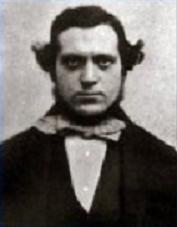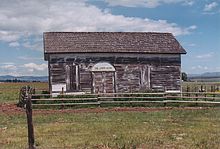Morrisite War
| Morrisite War | |||||||
|---|---|---|---|---|---|---|---|
| Part of the Mormon Wars | |||||||
| |||||||
| Belligerents | |||||||
| Morrisites |
| ||||||
| Commanders and leaders | |||||||
| Joseph Morris † |
| ||||||
| Units involved | |||||||
| None |
United States Marshals Service[citation needed] Nauvoo Legion | ||||||
| Strength | |||||||
| 200 - 500 Morrisite followers | 1,000 members of the territorial militia | ||||||
| Casualties and losses | |||||||
| Eight Morrisites (including at least four women) | One militia member | ||||||
The Morrisite War was a skirmish between a Latter Day Saint sect known as the "Morrisites" and the Utah territorial government.
Morrisites[edit]
In 1857 Joseph Morris, an English convert to The Church of Jesus Christ of Latter-day Saints in Utah, reported receiving revelations naming him the Seventh Angel from the Book of Revelation. He wrote to Brigham Young to seek recognition of his calling from the church.[1]
In 1860, Morris began to collect followers to a group that was commonly known as the Morrisites. In February 1861, John Taylor and Wilford Woodruff excommunicated him.[2] On April 6, 1861, he organized the Church of the Firstborn and called all of his followers to gather at Kington Fort,[3] a 3-acre (12,000 m2) fort on the Weber River which had been abandoned in 1858.[4] By fall 1861, the group contained several hundred followers.

Morris told his followers that the Second Coming was imminent and not to bother with planting crops. They may have trampled some of their crops into the ground as evidence of their faith.[2] The group pooled available supplies and waited at Kington Fort.
Dissension[edit]
By spring 1862, food was scarce and some members were becoming discontented. Morris repeatedly designated certain days for the Second Coming, only to have those days pass uneventfully.[5] Each time that happened, a handful of members would recover their possessions from the community pool and leave the congregation.
With the steady outflux of members, the question of property entitlement became contentious. Those who stayed behind felt those who left were taking better stock and other items than they had initially contributed to the community pool. Soon afterward, three departing members (William Jones, one of Morris's first converts, John Jensen, and Lars C. Geertsen) vowed revenge after what they perceived as an unfair reckoning, and they seized a load of wheat en route from Kington to Kaysville for milling. The Morrisites sent a group of men after them, and the group soon captured the three and the wheat. The church held the men prisoner in a small cabin, to be "tried by the Lord when he came."[1]
Government involvement[edit]
Geertsen soon escaped, but the other men's wives petitioned the territorial government for assistance. Word reached John F. Kinney, Who had been appointed two years earlier by James Buchanan as chief justice of the Utah Territory,[6] that the Morrisites were illegally holding prisoners. On May 24, he issued a writ of habeas corpus commanding the prisoners' release. U.S. Marshal Judson Stoddard brought the writ to Kington Fort and read it to the Morrisite leaders, who refused to receive it.[citation needed]
Kington Fort siege[edit]

After the Morrisites dishonored a similar writ three weeks later, Chief Justice Kinney asked the acting governor to activate the territorial militia as a posse comitatus to arrest the Morrisite leaders.[5] On June 12 a 200-man armed posse departed Salt Lake City for the fort, 30 miles (48 km) north.[2] Robert T. Burton, deputy U.S. Marshal, led the posse, which gathered strength along the way and was somewhere between 500[2] and a 100l[5] strong when it reached the settlement on June 13. By then, the Morrisites had barricaded themselves in the fort.
The posse positioned itself on bluffs southwest of the fort, with contingents on the flats to the east and the west. They situated cannons on two small ridges looking directly into the fort,[7] which in order to accommodate the hundreds of followers was really a makeshift enclosure. A militia from Ogden positioned itself to the north.[citation needed]
Burton sent a message via a Morrisite herd-boy requesting the group's surrender within thirty minutes. As soon as he received the message, Morris left his associates and soon returned with a new revelation, promising his people that the posse would be destroyed. He and his counselors had a bugle sounded to gather the congregation and read the revelation.[citation needed]
When the group did not respond within thirty minutes, Burton ordered two warning shots fired "to speed up the decision."[2] The second ball ricocheted off the ground and into the fort, killing two women and shattering the jaw of Mary Christoffersen. Some Morrisites returned the fire, killing the 19-year-old Jared Smith of the posse, the only non-Morrisite casualty of the war.[8]
Heavy rains prevented much action the next day, June 14. Historians differ as to what initiated the events of June 15,[1][5] but at some point, Burton rode into the fort with a small contingent. Details of what followed are also unclear, but Morris may have made a statement to his followers and approached Burton in what was interpreted as a threatening manner.[1] Burton shot and killed him, and two women[2] were also killed in the resulting melee. Morris's counsellor John Banks was mortally wounded. Burton took ninety men prisoner and marched them back to Salt Lake City the next morning to stand trial before Judge Kinney.[citation needed]
Aftermath[edit]

Seven of the Morrisites were convicted of second-degree murder in March 1863, and another 66 were convicted of resistance. However, Stephen S. Harding, the new federally-appointed territorial governor, pardoned them all[2] three days after the conviction. The Morrisites scattered across the west, but many of them ended up in Deer Lodge County, Montana.[1] A house of worship used by the Morrisites in Racetrack, Montana, still stands though in some disrepair (46°17′19″N 112°44′57″W / 46.2885°N 112.7493°W).
Seven years later, Robert T. Burton was tried and acquitted for the murder of Isabella Bowman, one of the women killed after the siege.[2]
Commemoration[edit]

A monument commemorating the Morrisite War was erected in South Weber, Utah, by the Daughters of Utah Pioneers, Sons of Utah Pioneers, and AllBuild Construction and Landscaping. The text of the monument follows:
The Kington Fort-Morrisite
War Site
This monument was placed here to commemorate a three-day, little-known battle that occurred 13, 14, and 15 June 1862.The Kington (Kingston) Fort a 645 foot by 645 foot enclosure was built on this site in 1853 to protect the early settlers from possible Indian attacks. Since there were no Indian problems in South Weber, the fort was deserted in 1858.
In early 1862 the fort was taken over by Joseph Morris, an excommunicated member of the Church of Jesus Christ of Latter day Saints, who had founded a church commonly known as the Morrisites. At one time the Morrisite fort population exceeded 200 men, women and children. In June 1862 three men, who no longer believed in Morris' teachings, attempted to leave the fort. They were captured by a Morrisite posse and forcefully returned to the fort. Responding to a report by observers of this action, the sheriff and a small posse approached the fort with the intention of taking the men for a formal hearing on the charges of which they were accused. The request was denied and further attempts were blocked. As a result, acting governor Frank Fuller ordered a militia under the command of Robert T. Burton to proceed to the fort. Even this large, Heavily armed group failed to free the imprisoned men. A cannon ball fired into the fort killed two women and seriously wounded a teenage girl. as the army assaulted the fort and breached the gates, two militiamen were killed. in the ensuing confusion, Morris, his second in command, John Banks and two more women were killed. in all, eleven people died.After the death of their leaders, the Morrisites scattered, with most going to Soda Springs, Idaho. Others settled in Carson City, Nevada and Deer Lodge, Montana. A few other members were rebaptized into the Church of Jesus Christ of Latter day Saints and remained in South Weber.
Erected by:
Daughters of Utah Pioneers-South Weber Chapter
Sons of Utah Pioneers-Ogden Pioneer Chapter
AllBuild Construction and LandscapingSite by Douglas B. Stephens
SUP#128
See also[edit]
References[edit]
- ^ a b c d e C. LeRoy Anderson Morrisite Collection Archived 2006-09-02 at the Wayback Machine. Marie Eccles-Caine Archive of Intermountain Americana. Utah State University Libraries: Special Collections and Archives. Accessed 9 May 2007.
- ^ a b c d e f g h Godfrey, Kenneth (1994). "The Morrisites". In Powell, Allan Kent (ed.). Utah History Encyclopedia. Salt Lake City, Utah: University of Utah Press. p. 674. ISBN 0874804256. OCLC 30473917.
- ^ Kington Fort was named for Bishop Thomas Kington. Kington was asked by Brigham Young to oversee the building of the fort. All earliest sources (notebook kept by Kington's wife, the gravestone of Thomas Kington, and the journals of Wilford Woodruff and early LDS Church records) agree that his name was spelled "Kington," but some later historians misspelled it "Kingston".
- ^ Malan, Ruth. "Three-day war focus of new monument". Standard-Examiner (Ogden, UT) November 2, 2006. Pluses Section.
- ^ a b c d Howard, G.M. "Men, Motives, and Misunderstandings: A New Look at the Morrisite War of 1862". Accessed 10 May 2007.
- ^ KINNEY, John Fitch, (1816 - 1902). Biographical Directory of the United States Congress. Accessed May 9, 2007
- ^ One history (of Evan Jenkins, who was part of the posse, see Life history of Evan and Ann Jenkins accessed on 11 May 2007) reports there were three cannons in total, "of which the historical 'Old Sow' was one, and two smaller ones known as the 'Iron and Brass Cannons'. The Old Sow had been owned by the Nauvoo Legion." It is not known which cannon fired the ball that ended up in the fort.
- ^ Smith was engaged to be married to his childhood sweetheart, Ane Marie Dorthea Nelson. After Smith was killed, his brother-in-law, Hugh Findlay, took her as a plural wife the next month and they raised their subsequent three children as Smith's. Ane died at age 29 in 1872.
Sources[edit]
- C. LeRoy Anderson, For Christ Will Come Tomorrow: The Saga of the Morrisites (1981).
- 1862 in Christianity
- Conflicts in 1862
- History of the Latter Day Saint movement
- Civil wars in the United States
- Latter Day Saint movement in Utah
- Mormonism and violence
- Religion-based wars
- Religiously motivated violence in the United States
- Riots and civil unrest during the American Civil War
- Utah Territory
- 19th-century Mormonism
- Riots and civil disorder in Utah
- 1862 in Utah Territory
- Wars fought in Utah
